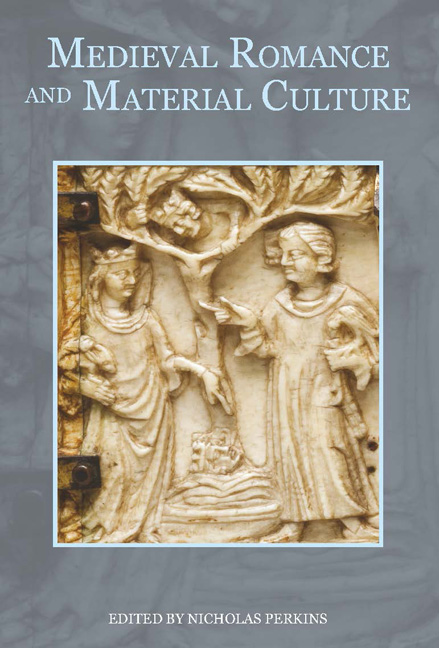23 results
Abbreviations
-
- Book:
- Medieval Romance and Material Culture
- Published by:
- Boydell & Brewer
- Published online:
- 05 May 2015
- Print publication:
- 16 April 2015, pp xiii-xiv
-
- Chapter
- Export citation
Contents
-
- Book:
- Medieval Romance and Material Culture
- Published by:
- Boydell & Brewer
- Published online:
- 05 May 2015
- Print publication:
- 16 April 2015, pp v-vi
-
- Chapter
- Export citation
Index
-
- Book:
- Medieval Romance and Material Culture
- Published by:
- Boydell & Brewer
- Published online:
- 05 May 2015
- Print publication:
- 16 April 2015, pp 275-285
-
- Chapter
- Export citation
Frontmatter
-
- Book:
- Medieval Romance and Material Culture
- Published by:
- Boydell & Brewer
- Published online:
- 05 May 2015
- Print publication:
- 16 April 2015, pp i-iv
-
- Chapter
- Export citation
6 - ‘Ladyes war at thare avowing’: The Female Gaze in Late-Medieval Scottish Romance
-
-
- Book:
- Medieval Romance and Material Culture
- Published by:
- Boydell & Brewer
- Published online:
- 05 May 2015
- Print publication:
- 16 April 2015, pp 91-110
-
- Chapter
- Export citation
List of Contributors
-
- Book:
- Medieval Romance and Material Culture
- Published by:
- Boydell & Brewer
- Published online:
- 05 May 2015
- Print publication:
- 16 April 2015, pp xi-xi
-
- Chapter
- Export citation
List of Illustrations
-
- Book:
- Medieval Romance and Material Culture
- Published by:
- Boydell & Brewer
- Published online:
- 05 May 2015
- Print publication:
- 16 April 2015, pp vii-x
-
- Chapter
- Export citation

Medieval Romance and Material Culture
-
- Published by:
- Boydell & Brewer
- Published online:
- 05 May 2015
- Print publication:
- 16 April 2015
Acknowledgements
-
- Book:
- Medieval Romance and Material Culture
- Published by:
- Boydell & Brewer
- Published online:
- 05 May 2015
- Print publication:
- 16 April 2015, pp xii-xii
-
- Chapter
- Export citation
2 - Erotic (Subject) Positions in Chaucer's Merchant's Tale
-
- Book:
- Sexual Culture in the Literature of Medieval Britain
- Published by:
- Boydell & Brewer
- Published online:
- 05 August 2014
- Print publication:
- 21 August 2014, pp 27-38
-
- Chapter
- Export citation
Frontmatter
-
- Book:
- Sexual Culture in the Literature of Medieval Britain
- Published by:
- Boydell & Brewer
- Published online:
- 05 August 2014
- Print publication:
- 21 August 2014, pp i-iv
-
- Chapter
- Export citation
Contents
-
- Book:
- Sexual Culture in the Literature of Medieval Britain
- Published by:
- Boydell & Brewer
- Published online:
- 05 August 2014
- Print publication:
- 21 August 2014, pp v-vi
-
- Chapter
- Export citation
Index
-
- Book:
- Sexual Culture in the Literature of Medieval Britain
- Published by:
- Boydell & Brewer
- Published online:
- 05 August 2014
- Print publication:
- 21 August 2014, pp 183-186
-
- Chapter
- Export citation
1 - ‘Open manslaughter and bold bawdry’: Male Sexuality as a Cause of Disruption in Malory's Morte Darthur
-
- Book:
- Sexual Culture in the Literature of Medieval Britain
- Published by:
- Boydell & Brewer
- Published online:
- 05 August 2014
- Print publication:
- 21 August 2014, pp 13-26
-
- Chapter
- Export citation
9 - Animality, Sexuality and the Abject in Three of Dunbar's Satirical Poems
-
- Book:
- Sexual Culture in the Literature of Medieval Britain
- Published by:
- Boydell & Brewer
- Published online:
- 05 August 2014
- Print publication:
- 21 August 2014, pp 127-146
-
- Chapter
- Export citation
Notes on Contributors
-
- Book:
- Sexual Culture in the Literature of Medieval Britain
- Published by:
- Boydell & Brewer
- Published online:
- 05 August 2014
- Print publication:
- 21 August 2014, pp 181-182
-
- Chapter
- Export citation
8 - Text as Stone: Desire, Sex, and the Figurative Hermaphrodite in the Ordinal and Compound of Alchemy
-
- Book:
- Sexual Culture in the Literature of Medieval Britain
- Published by:
- Boydell & Brewer
- Published online:
- 05 August 2014
- Print publication:
- 21 August 2014, pp 111-126
-
- Chapter
- Export citation
4 - ‘Naked as a nedyll’: The Eroticism of Malory's Elaine
-
- Book:
- Sexual Culture in the Literature of Medieval Britain
- Published by:
- Boydell & Brewer
- Published online:
- 05 August 2014
- Print publication:
- 21 August 2014, pp 55-68
-
- Chapter
- Export citation
7 - Fairy Lovers: Sexuality, Order and Narrative in Medieval Romance
-
- Book:
- Sexual Culture in the Literature of Medieval Britain
- Published by:
- Boydell & Brewer
- Published online:
- 05 August 2014
- Print publication:
- 21 August 2014, pp 99-110
-
- Chapter
- Export citation
3 - Enter the Bedroom: Managing Space for the Erotic in Middle English Romance
-
- Book:
- Sexual Culture in the Literature of Medieval Britain
- Published by:
- Boydell & Brewer
- Published online:
- 05 August 2014
- Print publication:
- 21 August 2014, pp 39-54
-
- Chapter
- Export citation



